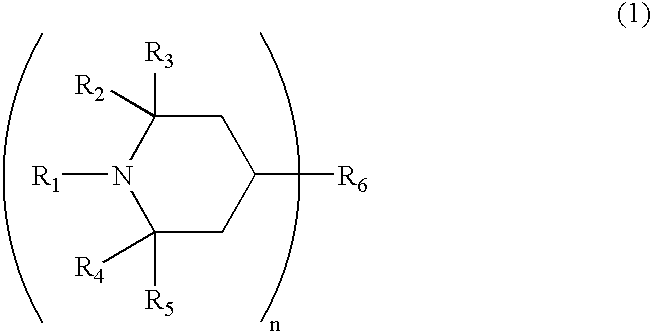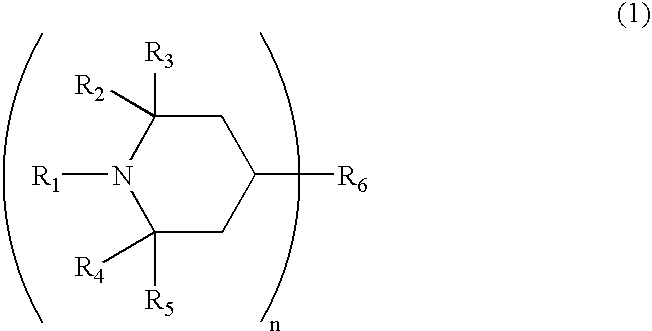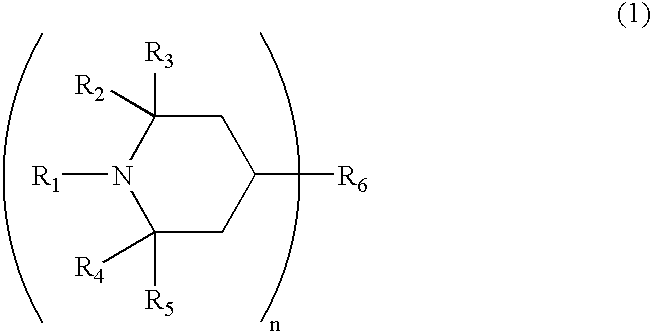Photochromic material
a technology of photochromic materials and materials, applied in the field of photochromic materials, can solve the problems of deteriorating practical applicability and color density drop, and achieve the effects of improving light fastness, water resistance, and enhancing color density
- Summary
- Abstract
- Description
- Claims
- Application Information
AI Technical Summary
Benefits of technology
Problems solved by technology
Method used
Image
Examples
application example 1
[0185]Twelve parts of the photochromic material prepared in Example 14 was blended with 100 parts of a SBS-based thermoplastic elastomer compound [a product of Aronkasei Co., Ltd. with a trade name of AR130]. The mixture was fabricated into a rod-shaped photochromic mold product by extrusion molding.
[0186]The thus obtained mold product looked milky white prior to exposure to sunlight. With exposure to sunlight, a pink color developed. Thereafter, when it was left indoors for a while, the pink color disappeared and returned to the original milky white appearance.
[0187]These color changes could be conducted repeatedly.
application example 2
[0188]Pellets were prepared by mixing 11 parts of the photochromic material obtained in Example 5 and 0.01 part of a copper phthalocyanine-based blue pigment with 100 parts of a high-density polyethylene [a product of Nippon Polyolefin Co., Ltd. with a trade name of KB145N].
[0189]By using the pellets thus prepared, a photochromic mold product in the shape of a container was produced by blow molding.
[0190]The mold product, which was blue prior to exposure to sunlight, turned violet with exposure to sunlight. By leaving the mold indoors for a while, the violet color disappeared returning to the initial blue appearance.
[0191]These color changes could be conducted repeatedly.
application example 3
[0192]Sixty parts of the photochromic material prepared in Example 16 was mixed in a mixed solution comprising 20 parts of an aromatic isocyanate pre-polymer as a film-forming material and 20 parts of ethyl acetate. Then, the resulting mixture was added in 100 parts of 15% aqueous gelatin solution dropwise in such a manner as to give rise to minute drops under stirring. The system was kept at 70° C. for one hr to undergo reaction.
[0193]Next, stirring was continued for additional 3 hr under keeping the fluid temperature at 90° C. to prepare a microcapsule dispersion. Thereafter, microcapsules were obtained by centrifugal separation.
[0194]The above-described microcapsules were dried by spray drying. Ten parts of the dried product was separated and homogeneously dispersed in a 15% xylene solution of an acrylic resin [a product of Rohm & Haas Co. with a trade name of Palaroid B-72], followed by dilution with xylene and methyl isobutyl ketone. In this way, a paint was obtained.
[0195]The ...
PUM
| Property | Measurement | Unit |
|---|---|---|
| softening point | aaaaa | aaaaa |
| melting point | aaaaa | aaaaa |
| boiling point | aaaaa | aaaaa |
Abstract
Description
Claims
Application Information
 Login to View More
Login to View More - R&D
- Intellectual Property
- Life Sciences
- Materials
- Tech Scout
- Unparalleled Data Quality
- Higher Quality Content
- 60% Fewer Hallucinations
Browse by: Latest US Patents, China's latest patents, Technical Efficacy Thesaurus, Application Domain, Technology Topic, Popular Technical Reports.
© 2025 PatSnap. All rights reserved.Legal|Privacy policy|Modern Slavery Act Transparency Statement|Sitemap|About US| Contact US: help@patsnap.com



